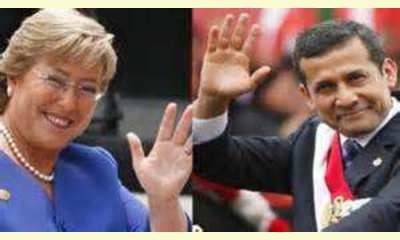|
|
Bachelet y Humala proyectan futuro de paz (Chile y Perú)
un articulo por Prensa Latina
La presidenta electa de Chile, Michelle Bachelet, y
el mandatario peruano, Ollanta Humala, proyectaron
hoy [27 enero] un futuro de paz entre los dos
países a raíz del fallo de la Corte de La Haya.

Presidentes Bachelet y Humala
click on photo to enlarge
Los estadistas coincidieron en declaraciones
emitidas en Santiago de Chile y Lima,
respectivamente, al referirse al veredicto de la
Corte Internacional de Justicia de La Haya,
Holanda, sobre un diferendo fronterizo marítimo.
Bachelet, quien en breve se reunirá en el Palacio
de la Moneda con el jefe de Estado, Sebastián
Piñera, destacó la cultura de paz de Chile y se
pronunció por incrementar la cooperación con Perú
durante su administración.
Hemos seguido con mucha atención el dictamen de La
Haya y nos congratulamos del reconocimiento del
paralelo en el Hito 1 que defiende nuestro país y
protege los derechos esenciales en un área de 80
millas, comentó.
No perdimos soberanía territorial y esto es muy
relevante, agregó.
Sin embargo, lamentó la determinación de establecer
una línea equidistante de las 80 millas del espacio
hasta la milla 200, aunque remarcó que la mayor
calidad de la pesca se produce en el rango de las
80 millas.
En horario casi coincidente, Humala consideró en
Lima que el fallo de La Haya es un triunfo para la
paz y abre un camino hacia la cooperación y mejores
vínculos entre dos naciones latinoamericanas.
El presidente Piñera, por su parte, valoró el
reconocimiento por la Corte en Holanda del Tratado
de 1954 y del Hito 1.
El fallo confirma que Chile mantiene la casi
totalidad de sus derechos de pesca y totalmente los
de nuestros pescadores artesanales, apuntó.
Deploró, empero, que se establezca en favor de
Perú una cesión de la zona económica exclusiva
comprendida entre las 80 y las 200 millas.
En Arica, capital de la provincia del mismo
nombre, próxima a la frontera con Perú y uno de
los puertos más activos de Chile, la población en
general se proyectó de manera pesimista y
emprendió una marcha por las calles con banderas
negras.
El Directorio Nacional de la Confederación Gremial
Nacional Unida de la Mediana, Pequeña,
Microindustria Servicios y Artesanado de Chile
instó a respetar y acatar el fallo de la Corte
Internacional de Justicia de la Haya.
( Clickear aquí para la version inglês)
|








|
DISCUSSION
Pregunta(s) relacionada(s) al artículo :
Latin America, has it taken the lead in the struggle for a culture of peace?
* * * * *
Comentario más reciente:
I argued in my blog this January that indeed Latin America is now the "leading edge" of the global movement for a culture of peace.
Latin America continues to take the lead in the transition to a culture of peace.
As indicated by this month’s CPNN Bulletin, the continent was the first to establish city culture of peace commissions, as well as city commissions for components such as human rights in Sao Paulo and sustainable development in Aguascalientes. Also the invocation of the culture of peace as the basis for the Union of South American States (UNASUR) was a pioneering development.
Now, we can add to this list of innovations, the development of the culture of peace at a regional level in Brazil, Peru and Mexico. As discussed, this is an important new step since a region can be self-sustaining with regard to its agricultural basis, unlike the city.
In fact, Latin America has always been at the leading edge. The initial concept came in 1986 from an initiative in Peru headed by the Jesuit scholar Felipe MacGregor. The first national project was in El Salvador in 1993, and that experience was the basis for the adoption of the culture of peace programme by the Executive Board and General Conference of UNESCO. The further development of the culture of peace as a social movement came in 1994 from a “Group of Reflection” of Latin American experts in association with UNESCO. It was the representatives from Latin American countries at the United Nations in New York that began in 1995 the annual resolutions which led eventually to the UN Declaration and Programme of Action on a Culture of Peace. And the initial call for an International Year for the Culture of Peace came from a meeting of Latin American newspaper editors in Puebla, Mexico, in 1997.
The second and third largest number of signatures on the Manifesto 2000, by which individuals promised to support a culture of peace in their daily lives, came from Brazil (15 million) and Colombia (11 million).
During the International Decade for a Culture of Peace from 2001-2010, the rich countries, including Europe and the United States and their allies, refused to support the culture of peace, including its annual UN resolutions. . ... continuación.

|
|









